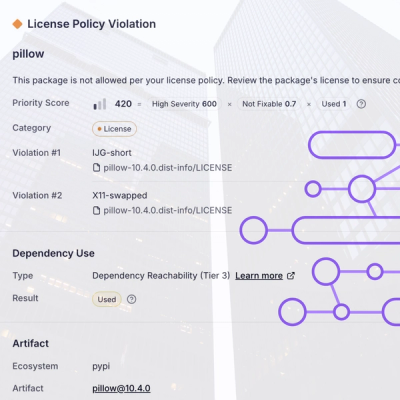
Research
/Security News
Critical Vulnerability in NestJS Devtools: Localhost RCE via Sandbox Escape
A flawed sandbox in @nestjs/devtools-integration lets attackers run code on your machine via CSRF, leading to full Remote Code Execution (RCE).
Django app for managing temporary session-based users.
This project currently supports Python 3.10+, Django 4.2+.
This package has been extracted out of django-request-token as a specific use
case - that of temporary site "visitors". It enables a type of ephemeral user
who is neither anonymous nor authenticated, but somewhere in between - known for
the duration of their session.
We've been using django-request-token for a while, and have issued over
100,000 tokens. A recent analysis showed two main use cases - single-use "magic
links" for logging people in, and a more involved case where we invite
unregistered users on to the platform to perform some action - providing a
reference perhaps, or collaborating on something with (registered) users. The
former we have extracted out into django-magic-links - and this package
addresses the latter.
In the standard Django model you have the concept of an AnonymousUser, and an
authenticated User - someone who has logged in. We have a third, intermediate,
type of user - which we have historically referred to as a "Temp User", which is
someone we know of, but who has not yet registered.
The canonical example of this is leaving a reference: user A on the site invites
user B to leave a reference for them. They (A) give us B's name and email, we
invite them to click on a link and fill out a form. That's it. We store their
name and email so that we can contact them, but it's ephemeral - we don't need
it, and we don't use it. Storing this data in the User table made sense (as it
has name and email fields), but it led to a lot of user_type=TEMP munging to
determine who is a 'real' user on the site.
What we really want is to 'stash' this information somewhere outside of the auth system, and to enable these temp users to have restricted access to specific areas of the application, for a limited period, after which we can forget about them and clear out the data.
We call these users "visitors".
Fred is a registered user on the site, and would like a reference from Ginger, his dance partner.
Name: Ginger
Email: ginger@[...].com
Message: ...
Scope: REFERENCE_REQUEST [hidden field]
We save this information, and generate a unique link which we send to Ginger, along with the message.
Ginger clicks on the link, at which point we recognise that this is someone
we know about - a "visitor" - but who is in all other respects an
AnonymousUser.
We stash the visitor info in the standard session object - so that even though Ginger is not authenticated, we know who she is, and more importantly we know why she's here (REFERENCE_REQUEST).
Ginger submits the reference - which may be a multi-step process, involving
GETs and POSTs, all of which are guarded by a decorator that restricts access
to visitors with the appropriate Scope (just like django-request-token).
At the final step we can (optionally) choose to clear the session info immediately, effectively removing all further access.
This code has been extracted out of django-request-token and simplified. It
stores the visitor data in the Visitor model, and on each successful first
request (where the token is 'processed' and the session filled) we record a
VisitorLog record. This includes HTTP request info (session_key, referer,
client IP, user-agent). This information is for analytics only - for instance
determining whether links are being shared.
The app works by adding some attributes to the request and request.user
objects. The user has a boolean user.is_visitor property, and the request has
a request.visitor property which is the relevant Visitor object.
This is done via two bits of middleware, VisitorRequestMiddleware and
VisitSessionMiddleware.
VisitorRequestMiddlewareThis middleware looks for a visitor token (uuid) on the incoming request
querystring. If it finds a token, it will look up the Visitor object, add it
to the request, and then set the request.user.is_visitor attribute. It sets
the properties from the request, and has no interaction with the session. This
happens in the second piece of middleware.
VisitorSessionMiddlewareThis middleware must come after the VisitorRequestMiddleware (it will blow up
if it can't access request.visitor). It has two responsibilities:
If the request object has a visitor object on it, then it must have been
set by the request middleware on the current request - so it's a new visitor,
and we immediately stash it in the request.session.
If request.visitor is None, then we don't have a new visitor, but there
may be one already stashed in the request.session, in which case we want to
add it on the to the request.
Note: splitting this in two seems over-complicated, but because we are moving values from request-into-session-into-request it's a lot simpler to run two completely separate passes.
visitors to INSTALLED_APPSvisitors.middleware.VisitorRequestMiddleware to MIDDLEWAREvisitors.middleware.VisitorSessionMiddleware to MIDDLEWAREVISITOR_SESSION_KEY: session key used to stash visitor info (default:
visitor:session)
VISITOR_SESSION_EXPIRY: session expiry in seconds (default: 0 - meaning
that it will expire when the browser is closed.) This settings applies
as the default for all new visitor objects, but can be overridden on a
per-object basis.
VISITOR_QUERYSTRING_KEY: querystring param used on tokenised links (default:
vuid)
Once you have the package configured, you can use the user_is_visitor
decorator to protect views that you want to restricted to visitors only. The
decorator requires a scope kwarg, which must match the Visitor.scope value
set when the Visitor object is created.
@user_is_visitor(scope="foo")
def protected_view(request):
pass
By default the decorator will allow visitors with the correct scope only. If you
want more control over the access, you can pass a callable as the bypass_func
param:
# allow authenticated users as well as visitors
@user_is_visitor(scope="foo", bypass_func=lambda r: r.user.is_staff)
def allow_visitors_and_staff(request):
pass
If you don't care about the scope (you should), you can use "*" to allow all
visitors access:
@user_is_visitor(scope="*") # see also SCOPE_ANY
def allow_all_scopes(request):
pass
Alternatively, for more complex use cases, you can ignore the decorator and just inspect the request itself:
def complicated_rules(request):
if request.user.is_visitor:
pass
elif is_national_holiday():
pass
elif is_sunny_day():
pass
else:
raise PermissionDenied
FAQs
Django app for managing temporary session-based users.
We found that django-visitor-pass demonstrated a healthy version release cadence and project activity because the last version was released less than a year ago. It has 1 open source maintainer collaborating on the project.
Did you know?

Socket for GitHub automatically highlights issues in each pull request and monitors the health of all your open source dependencies. Discover the contents of your packages and block harmful activity before you install or update your dependencies.

Research
/Security News
A flawed sandbox in @nestjs/devtools-integration lets attackers run code on your machine via CSRF, leading to full Remote Code Execution (RCE).

Product
Customize license detection with Socket’s new license overlays: gain control, reduce noise, and handle edge cases with precision.

Product
Socket now supports Rust and Cargo, offering package search for all users and experimental SBOM generation for enterprise projects.